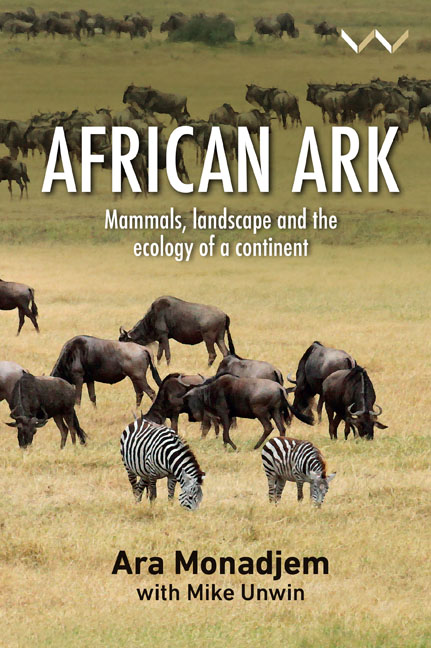Book contents
- Frontmatter
- Dedication
- Contents
- List of Plate Photographs
- List of Figures and Tables
- Acknowledgements
- Foreword
- Preface
- Chapter 1 A Continent of Plenty
- Chapter 2 The Species Conundrum
- Chapter 3 The History of Africa’s Mammals
- Chapter 4 Islands as Species Factories
- Chapter 5 Evolution on the African Mainland
- Chapter 6 Giant Mammals Shaping the Landscape
- Chapter 7 A Place for Every Species
- Chapter 8 Fluctuating Populations
- Chapter 9 The Human Factor
- Chapter 10 The Sinking Ark?
- Glossary
- Notes
- References
- Recommended Reading
- Index
Chapter 7 - A Place for Every Species
Published online by Cambridge University Press: 29 November 2023
- Frontmatter
- Dedication
- Contents
- List of Plate Photographs
- List of Figures and Tables
- Acknowledgements
- Foreword
- Preface
- Chapter 1 A Continent of Plenty
- Chapter 2 The Species Conundrum
- Chapter 3 The History of Africa’s Mammals
- Chapter 4 Islands as Species Factories
- Chapter 5 Evolution on the African Mainland
- Chapter 6 Giant Mammals Shaping the Landscape
- Chapter 7 A Place for Every Species
- Chapter 8 Fluctuating Populations
- Chapter 9 The Human Factor
- Chapter 10 The Sinking Ark?
- Glossary
- Notes
- References
- Recommended Reading
- Index
Summary
So far in this book, we have examined the forces that have shaped African fauna over big expanses of both time and space. In this chapter we will zoom in closer and observe on a finer scale how species distribute themselves in the here and now. This is the domain of ‘community ecology’, which seeks to understand how species arrange themselves into groups that give the appearance of organised communities.
INDIVIDUALS OR SUPER-ORGANISMS?
At the core of community ecology lies a centuries-old debate: do species react individually to changes in the environment, or do they instead assemble into organised communities? We need to understand this difference, because it lies at the heart of the debate. The great German naturalist and explorer Alexander von Humboldt (1769–1859) developed, almost from scratch, the field of plant geography. He surmised that different plant species are bound together in vegetation associations that can be defined by their life forms – namely, their general appearance and habits. He based his conclusions on his Andean expedition of 1801–1803, during which he meticulously recorded the species of plants occurring at various forest sites up steep elevational gradients (Wulf 2015). This may not sound novel today, in an era when the concept of vegetation types is widely understood, but it was a far cry from the practice of the times, which dictated a focus on individual species rather than on plant communities.
A century later, this concept was further developed by Frederic Clements who, in 1916, likened plant communities to ‘super-organisms’ and contended that each community functions as an organic entity (Nicolson 2013). In other words, when we look at a savanna or forest, we are not observing a collection of different species eking out their livings individually at the same location, but rather seeing a highly interconnected and integrated system that has collectively, so to speak, a life of its own. Furthermore, this super-organism has emergent properties. This became the informed position of botanists for several decades, with Henry Gleason representing a lone voice to the contrary. Gleason argued that plants respond individualistically to environmental changes (such as gradients in elevation or temperature) and to biotic interactions such as predation and competition. Therefore, the ‘community’ that we see is simply a snapshot of a particular landscape at a particular point in time and, when viewed over an extended period, turns out to be an illusion.
- Type
- Chapter
- Information
- African ArkMammals, Landscape and the Ecology of a Continent, pp. 149 - 169Publisher: Wits University PressPrint publication year: 2023

